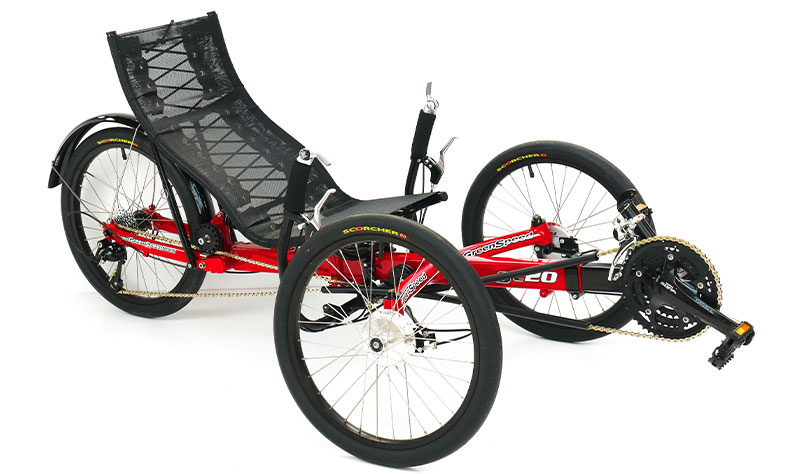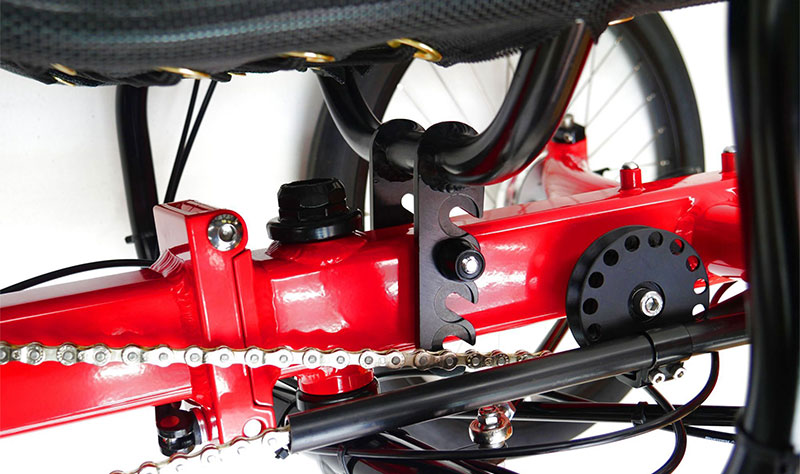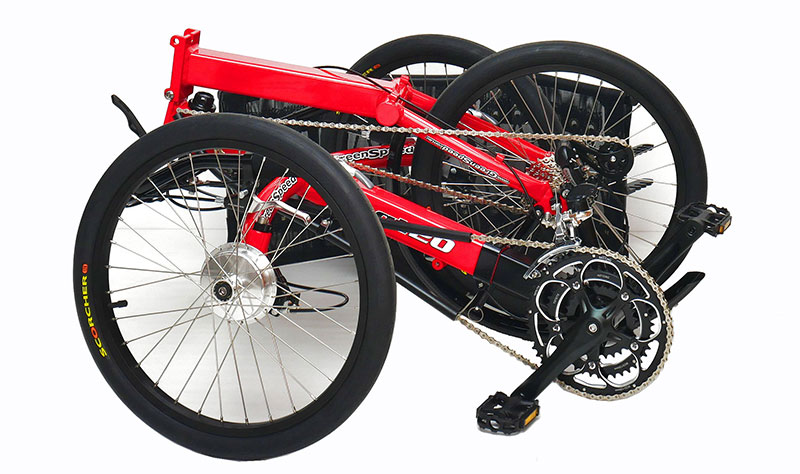Greenspeed GT 20 RS

Greenspeed Magnum GT20 RS Review on May 16, 2022
Greenspeeds founder, Ian Sims, started building recumbent trikes in Australia back in 1990. I knew Ian personally and he quite innovative person. Ian was the kind of person that if someone presented him an engineering challenge he would say “I can do that and I think I can do it better”. In short, if there was an engineering problem, he was driven to find the best solution for it. Ian was never about trying to grow Greenspeed into a hundred-million dollar company; he was just too busy having fun tinkering in his work shop in Australia.
Ian came from a racing background. He was heavily involved in side-car motorcycle racing, designing, and building. His designs were some of the faster motorcycles on the track. Ian was asked by a local college to help with some trike design for a competition which consequently got him involved in human-powered bicycle racing. By helping the local college kids make two radically different trike designs, the college team was awarded 1st and 2nd place on their 1st try. Ian then started getting a reputation with building trikes. Shortly after, two people who wanted to do a perimeter tour around Australia approached him. Ian built them two trikes and they worked flawlessly for the entire journey. Following his trip to the United States, his trike-building career took off. From the trip, Ian had a better idea of what people wanted and needed in the US. Ian then spent the next two years developing the Magnum series of trikes.
Frame: The frame on the Greenspeed Magnum GT 20 RS is made of aluminum that is TIG welded together in Taiwan. I believe the welds are beautiful and certainly of the highest quality in the industry. Ian chose a premium Rock Shox rear shock which is air adjustable rather than a simple coil spring like other manufacturers use. The Magnum GT 20 RS has a light frame with a maximum rider weight capacity of 300 Lbs.
All Magnum series of trikes frames fold for easy transportation and storage. The folding is performed by removing the two seat pins on the back of the seat and undoing the seat quick release on the bottom of the seat. As a result, it can be removed in about ten seconds without using any tools. The frame has a quick release in the center of the trike and the rear wheel folds up on top. The rear wheel comes to rest between the left front wheel and the boom. This method is, comparatively, much easier than other brands that have you fold the rear wheel under the main frame.
Paint: Overall, the Greenspeed paint jobs are very nice. The trikes have a very even and consistent paint job done. Their frame manufacture has got the process down and the paint jobs will last for a long time.
Drive Train: The shifting is superb on the Magnum GT 20 RS. Particularly, Greenspeed chose a Shimano drivetrain with nine gears in front and three in the front for 27 total speeds. The Shimano front and rear derailleur performs flawlessly mated to the Shimano Dur-Ace Bar End Shifters. Greenspeed prefers Bar End Shifters and you will see them on all their trikes. Without a doubt, bar end shifters are my shifter of choice as well.
Brakes: Greenspeed chose the Sturmey Archer Drum brakes and Tektro brand brake levers for the Magnum GT 20 RS. To help getting in and out the trike, you can lock the front tires with a pin on the levers. The drum brakes simultaneously look very nice and are the right choice for this trike. Ian likes the drum brakes and you will see them used on most Greenspeed trike models. Drum brakes offer more consistent stopping power than disc brakes because the brake surface and brake pads never get wet. I have no issues with the Sturmey Archer drum brakes. They are simple, reliable, easily adjustable, and stop well. The brakes have about four times the brake pad material as a disc brake and will last far longer. Greenspeed also has quick-release axles which make removing the wheels a snap.
Seat: Ian told me that he specifically had a chiropractor friend that helped him with the development of the seat shape. The seat frame is made of aluminum and the seat fabric is a simple mesh. With all the padded seat fabrics on the market, you would think the Greenspeed has been left behind, but that is not the case.If you look at all the positives, it is truly a wonderful seat. Some padded seats can hold in heat and become uncomfortable but the Magnum GT 20 seat is much more breathable. The seat fabric is held to the seat frame with a shock cord. It wraps around the sides of the seat frame and provides a small bit of suspension. You would not think this is going to make a noticeable difference in comfortability but it does.
While riding the trike, putting your hand on the side of the seat frame can have you actually feel the movement of the seat fabric around the seat frame when you hit a bump. I have seen well-used trikes where movement of the seat fabric has worn off the anodization. Ian also made the seat height adjustable. If you have difficulty getting in and out of a trike, the Magnum GT 20 seat height can be adjusted from 12 inches to 17 inches off the ground. The seat angle can be adjusted from 30 degrees to 48 degrees so you can find that perfect comfort position.
Handling: Many recumbent trikes have “direct” (tiller type) steering, where, for cheapness, the handle bars are clamped directly onto the kingpins without any intermediate linkage, and the bars have to be moved in the opposite direction to which you are going, with the weaker muscles of your arms. Meanwhile, the GreenSpeed “Crossover” steering was invented by GreenSpeed to provide control with your bicep muscles, thus the steering is much easier and more intuitive to use. Furthermore, unlike other types of “indirect” trike steering, the GS Crossover steering provides superior Ackermann compensation, and a smaller turning circle, due to the fact that the steering rods cross over from one side to the other.
Greenspeed, and other companies, have discovered the rolling resistance of tires doesn’t increase until a camber angle of 10 degrees. To improve stability without making the trike wider, to counteract tire distortion while cornering, and to reduce rolling resistance in the turns, the Magnum GT 20 front wheels have 5 degrees of negative camber. On tight turns, the steering geometry changes the camber of the inside wheel from negative to positive, to reduce rolling resistance and tire scrub in the turns. Also, you get more use if you swap the tires half way through their life than if they were vertical.
Unlike a bike, the front wheels of a trike are offset some distance from the center line of the machine. Thus, applying one front wheel brake will tend to steer the trike in that direction. To compensate for this, the Magnum GT 20 has Negative Scrub Radius steering geometry, whereby the brake reaction steers the trike in the opposite direction to which side the brake is being pulled. This happens so subtly that all the rider notices is that the trike continues in a straight line when only one front brake is used. However, both brakes should be used for emergency braking as this will double the braking power.
Ride: I think the ride is incredible for me but that does not mean it is incredible for you. I like fast and light and the Magnum GT 20 RS is all that. Additionally, with the added rear suspension, you end up with fast, light, and extra comfortable. I think Ian designed this incredible trike for someone just like me. The Scorchers do not have any puncture resistant material in the bottom of the tire like the Schwalbe Marathon Plus. That means the tire is much more compliant but more apt to getting a puncture. Nonetheless, I am a big fan or the Scorcher tires that they use. They have a nice soft side wall which contributes to improved flexibility improving ride quality and rolling ability.
In conclusion: I would not call this a race trike but a high performance trike that has exceptional handling and a very comfortable ride.
Pros:
- Light
- Fast
- Exceptional Handling
- Rear suspension
- Only 39 Lbs
Cons:
- Special cassette from Shimano which can be hard to get
Best Place to Buy:
Your local bike shop or www.industrialbicycles.com



Seat
- Seat height: 12 – 17″ (305 – 432 mm)
- Angle: 30-48°
Wheels and Tires
- Front wheel size: 20” Alloy rims with Stainless Steel Spokes
- Rear wheel size: 20” Alloy rims with Stainless Steel Spokes
Measurements
- Bottom bracket height: 14″ (355.6 mm)
- Ground clearance: 6″ (152.4 mm)
- Wheelbase: 39” (990.6 mm)
- Track width: 29.5″ (749.3 mm)
- Total width: 31″ (789.3 mm)
- Max length: 76″ (1930.4 mm)
- Total height: 27″ (685.8 mm)
- Turning circle: 12′ (3.7 m)
- Folded size: 34 x 28 x 15″ (863.6 x 711.2 x 381 mm)
Specifications
- Suspension travel: rear 4″ (101.6 mm)
- Weight: 39 lbs (17.7 kg)
- Max payload: 300 lbs (136 kg)
- Frame material: 7005 Aluminum Alloy
- X-Seam Range: 41 – 51” (1041.4 – 1295.4 mm)